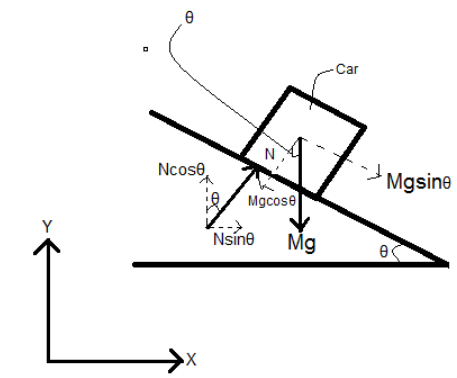
Assuming the coefficient of friction between the road and tires of a car to be 0.5, the maximum speed with which the car can move around a curve of 40.0m radius without slipping if the road is unbanked, should be
A. 25m/s
B. 19m/s
C. 14m/s
D. 11m/s
Answer
220.2k+ views
Hint: The practise of banking roads allows a car to travel around a curved track at a decent speed without skidding by lifting the outer edge of the curved road above the inner edge. To, solve this question we need to remember the concept of banking of road and the relation between the maximum velocity and coefficient of friction, which is given by ${{v}_{\max }}=\sqrt{\mu Rg}$
Formula used:
${{v}_{\max }}=\sqrt{\mu Rg}$
Where v is the velocity, R is the radius and $\mu $is the coefficient of friction and g is the acceleration due to gravity.
Complete answer:
We’ll start by equating all the forces and by trying to keep the body in equilibrium as shown in the diagram below:

Let’s balance all the forces along the x axis
$f\cos \theta +N\sin \theta =\dfrac{m{{v}^{2}}}{R}$
We will now substitute $f=\mu N$ in the above equation we get,
$\mu N\cos \theta +N\sin \theta =\dfrac{m{{v}^{2}}}{R}$
$\mu (\cos \theta +\sin \theta )=\dfrac{m{{v}^{2}}}{R}$…….. (i)
Now similarly let’s balance all the forces along y axis
$N\cos \theta =f\sin \theta +mg$
$\Rightarrow N\cos \theta =\mu N\sin \theta +mg$
$\Rightarrow N(\cos \theta -\mu \sin \theta )=mg$…… (ii)
And frictional force Frictional force,$f=\mu N$.….. (iii)
Now we will divide the equation (i) by (ii), we get
$\dfrac{{{v}^{2}}}{Rg}=\dfrac{(\mu +\tan \theta )}{(1-\mu \tan \theta )}$
$\Rightarrow v=\sqrt{\dfrac{Rg(\mu +\tan \theta )}{(1-\mu \tan \theta )}}$.
For maximum velocity the road is unbanked,$\theta =0{}^\circ $
Therefore, ${{v}_{\max }}=\sqrt{\mu Rg}$
Now, in the given question we need to find v.
Given value of$R=40.0m$, $\mu =0.5$,$g=10m/{{s}^{2}}$.
Putting the value in ${{v}_{\max }}=\sqrt{\mu Rg}$.
We get,
$v=\sqrt{40\times 0.5\times 10}$
$\Rightarrow v=14.14m/s\approx 14m/s$
Hence, the correct option is C. 14m/s
Note: Students should fully grasp the idea of road banking because doing so will improve their ability to solve mechanical problems. Students should remember that prior knowledge of frictional force and centripetal force will help them better understand the idea of road banking.
Formula used:
${{v}_{\max }}=\sqrt{\mu Rg}$
Where v is the velocity, R is the radius and $\mu $is the coefficient of friction and g is the acceleration due to gravity.
Complete answer:
We’ll start by equating all the forces and by trying to keep the body in equilibrium as shown in the diagram below:

Let’s balance all the forces along the x axis
$f\cos \theta +N\sin \theta =\dfrac{m{{v}^{2}}}{R}$
We will now substitute $f=\mu N$ in the above equation we get,
$\mu N\cos \theta +N\sin \theta =\dfrac{m{{v}^{2}}}{R}$
$\mu (\cos \theta +\sin \theta )=\dfrac{m{{v}^{2}}}{R}$…….. (i)
Now similarly let’s balance all the forces along y axis
$N\cos \theta =f\sin \theta +mg$
$\Rightarrow N\cos \theta =\mu N\sin \theta +mg$
$\Rightarrow N(\cos \theta -\mu \sin \theta )=mg$…… (ii)
And frictional force Frictional force,$f=\mu N$.….. (iii)
Now we will divide the equation (i) by (ii), we get
$\dfrac{{{v}^{2}}}{Rg}=\dfrac{(\mu +\tan \theta )}{(1-\mu \tan \theta )}$
$\Rightarrow v=\sqrt{\dfrac{Rg(\mu +\tan \theta )}{(1-\mu \tan \theta )}}$.
For maximum velocity the road is unbanked,$\theta =0{}^\circ $
Therefore, ${{v}_{\max }}=\sqrt{\mu Rg}$
Now, in the given question we need to find v.
Given value of$R=40.0m$, $\mu =0.5$,$g=10m/{{s}^{2}}$.
Putting the value in ${{v}_{\max }}=\sqrt{\mu Rg}$.
We get,
$v=\sqrt{40\times 0.5\times 10}$
$\Rightarrow v=14.14m/s\approx 14m/s$
Hence, the correct option is C. 14m/s
Note: Students should fully grasp the idea of road banking because doing so will improve their ability to solve mechanical problems. Students should remember that prior knowledge of frictional force and centripetal force will help them better understand the idea of road banking.
Recently Updated Pages
Mass vs Weight: Key Differences Explained for Students

Electricity and Magnetism Explained: Key Concepts & Applications

JEE Energetics Important Concepts and Tips for Exam Preparation

JEE Isolation, Preparation and Properties of Non-metals Important Concepts and Tips for Exam Preparation

JEE Main 2021 July 25 Shift 1 Question Paper with Answer Key

JEE Main 2021 July 22 Shift 2 Question Paper with Answer Key

Trending doubts
JEE Main 2026: Application Form Open, Exam Dates, Syllabus, Eligibility & Question Papers

Understanding Uniform Acceleration in Physics

Derivation of Equation of Trajectory Explained for Students

Hybridisation in Chemistry – Concept, Types & Applications

Understanding the Angle of Deviation in a Prism

How to Convert a Galvanometer into an Ammeter or Voltmeter

Other Pages
Thermodynamics Class 11 Physics Chapter 11 CBSE Notes - 2025-26

JEE Advanced Marks vs Ranks 2025: Understanding Category-wise Qualifying Marks and Previous Year Cut-offs

Units And Measurements Class 11 Physics Chapter 1 CBSE Notes - 2025-26

NCERT Solutions For Class 11 Physics Chapter 8 Mechanical Properties Of Solids

Motion in a Straight Line Class 11 Physics Chapter 2 CBSE Notes - 2025-26

Laws of Motion Class 11 Physics Chapter 4 CBSE Notes - 2025-26




